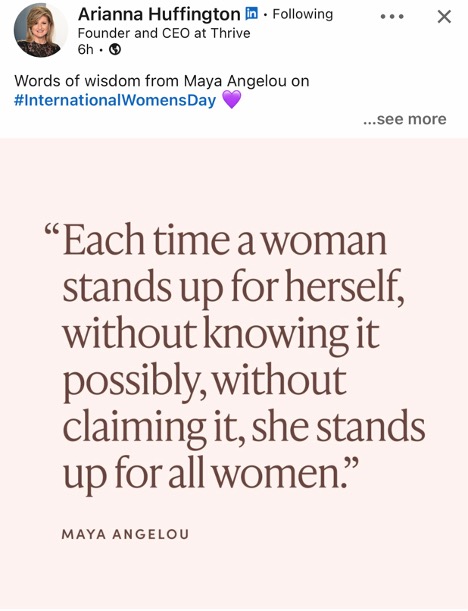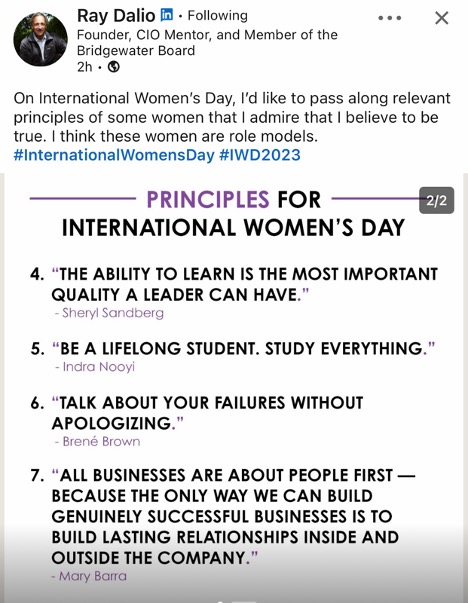International Women’s Day
March 8, 2023
Hello everyone,
International Women’s Day has rolled around again. Women across the world use this day to come together to celebrate and rally for equal treatment and representation. It is also a day to celebrate female achievement, to encourage and inspire one another, and to thank the women in our lives for their contribution to society.
The day’s origins date back to 1908, when thousands of women marched through New York City, demanding better working hours and pay. A year later, the Socialist party of America declared a Women’s Day.
While some glass ceilings have been shattered, others remain.
Let’s look at the achievements of women in U.S. history.
March 31, 1776: In a letter to her husband, Founding Father John Adams, future first lady, Abigail Adams makes a plea to him and the Continental Congress to “remember the ladies and be more generous and favourable to them than your ancestors…”
July 19-20, 1848: In the first women’s rights convention organized by women, the Seneca Falls Convention is held in New York, with 300 attendees, including organizers Elizabeth Cady Stanton and Lucretia Mott. Sixty-eight women and 32 men sign the Declaration of Sentiments, which sparked decades of activism, eventually leading to the passage of the 19th Amendment granting women the right to vote.
January 23, 1849: Elizabeth Blackwell becomes the first woman to graduate from medical school and become a doctor in the U.S. Born in Bristol, England, she graduated from Geneva College in New York with the highest grades in her entire class.
Dec 10, 1869: The legislature of the territory of Wyoming passes America’s first woman suffrage law, granting women the right to vote and hold office. In 1890, Wyoming is the 44th state admitted to the Union and becomes the first state to allow women the right to vote.
October 16, 1916: Margaret Sanger opens the first birth control clinic in the United States. Located in Brownsville, Brooklyn, her clinic was deemed illegal under the “Comstock Laws” forbidding birth control, and the clinic was raided on October 26, 1916. She closed the clinic eventually after further threats and eventually founded the American Birth Control League in 1921 – the precursor to today’s Planned Parenthood.
April 2, 1917: Jeanette Rankin of Montana, a longtime activist with the National Woman Suffrage Association, is sworn in as the first woman elected to Congress as a member of the House of Representatives.
August 18, 1920: Ratification of the 19th Amendment to the U.S. Constitution is completed, declaring “the right of citizens of the United States to vote shall not be denied or abridged by the United States or by any State on account of sex.”
May 20-21, 1932: Amelia Earhart becomes the first woman, and second pilot ever to fly solo nonstop across the Atlantic.
December 1, 1955: Black seamstress Rosa Parks refuses to give up her seat to a white man on a bus in Montgomery, Alabama. The move helps launch the civil rights movement.
May 9, 1960: The Food and Drug Administration (FDA) approves the first commercially produced birth control pill in the world, allowing women to control when and if they have children.
June 10, 1963: President John F. Kennedy signs into law the Equal Pay Act, prohibiting sex-based wage discrimination between men and women performing the same job in the same workplace.
July 2, 1964: President Lyndon B. Johnson, signs the Civil Rights Act into law; Title VII bans employment discrimination based on race, religion, national origin, or sex.
June 30, 1966: Betty Friedan, author of 1963’s The Feminine Mystique, helps found the National Organisation for Women (NOW), using grassroots activism to promote feminist ideals, lead societal change, eliminate discrimination, and achieve and protect the equal rights of all women and girls in all aspects of social, political and economic life.
January 22, 1973: In its landmark 7-2 Roe v. Wade decision, the U.S. Supreme Court declares that the Constitution protects a woman’s legal right to an abortion. In June 2022, the Supreme Court overturned the ruling.
July 7, 1981: Sandra Day O’Connor is sworn in by President Ronald Reagan as the first woman to serve on the U.S. Supreme Court. She retires in 2006, after serving for 24 years.
June 18, 1983: Flying on the Space Shuttle Challenger, Sally Ride becomes the first American woman in space.
July 12, 1984: Democratic presidential nominee Walter Mondale names U.S. Rep. Geraldine Ferraro (N.Y) as his running mate, making her the first woman vice presidential nominee by a major party.
March 12, 1993: Nominated by President Bill Clinton, Janet Reno is sworn in as the first female attorney general of the United States.
January 23, 1997: Also nominated by Clinton, Madeleine Albright is sworn in as the nation’s first female secretary of state.
January 4, 2007: U.S. Rep. Nancy Pelosi becomes the first female speaker of the House. In 2019, she reclaims the title, becoming the first lawmaker to hold the office two times in more than 50 years. She stepped down from the leadership role in 2022.
January 24, 2013: The U.S. military removes a ban against women serving in combat positions.
July 26, 2016: Hillary Clinton becomes the first woman to receive a presidential nomination from a major political party.
January 20, 2021: Kamala Harris is sworn in as the first woman and first woman of colour vice president of the United States.
I think we have come a long way, but there is still a long journey ahead.
Challenges are many, and change will be incremental.
Women need to stay the course.
Enjoy your week.
Cheers,
Jacque





